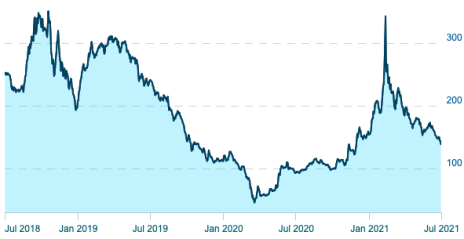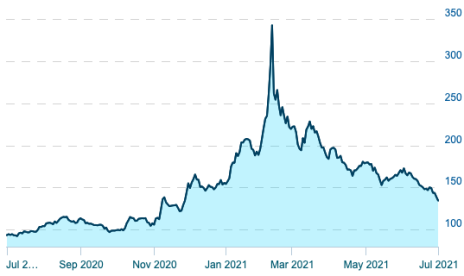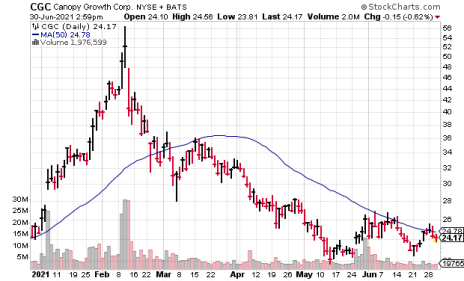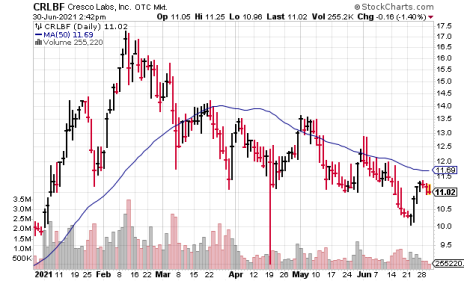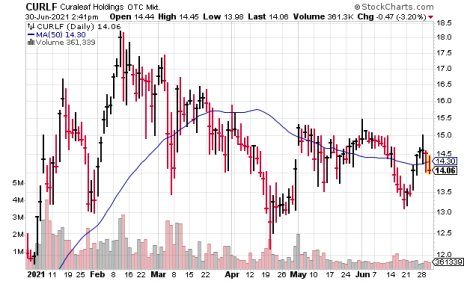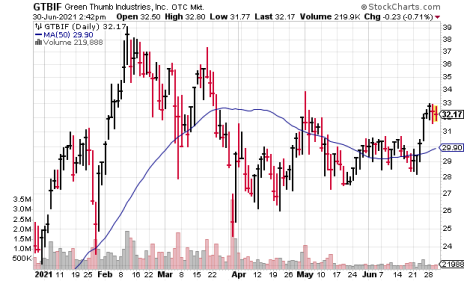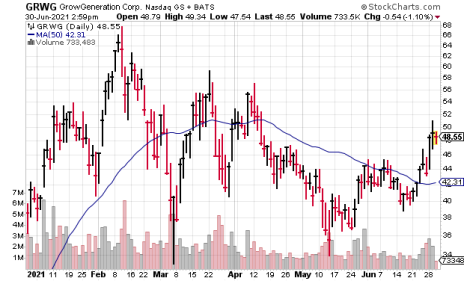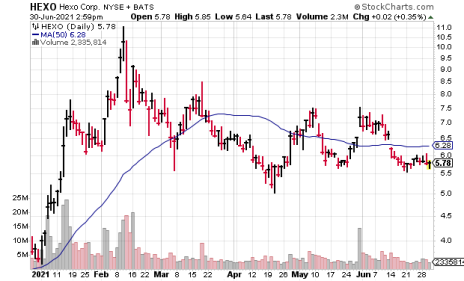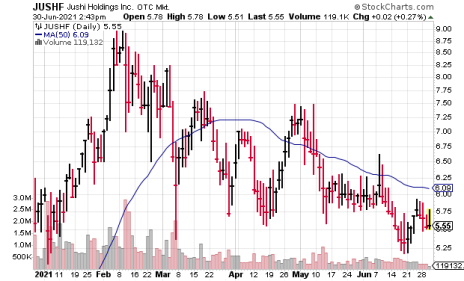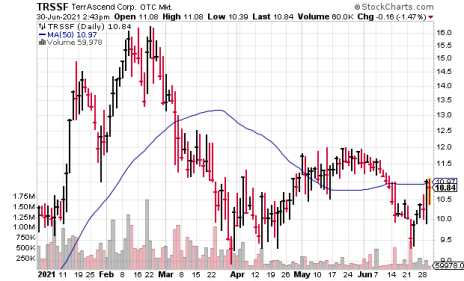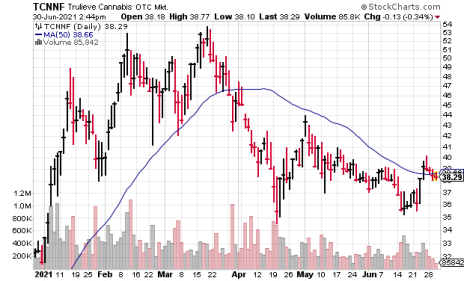The marijuana sector peaked in February, bottomed from late March to mid-April, and since then has been building a base, preparing for a resumption of the big advance.
Fundamentals in the industry remain terrific, and the messy but real trend toward legalization in the U.S. continues, so it’s only a matter of time before these stocks enjoy their next upwave.
In the portfolio today there are no changes.
Full details in the issue.
Cabot Marijuana Investor 621
Marijuana Industry Trends
In the early years of marijuana legalization in the U.S., when the main action was in Colorado and the three West Coast states, there were no major multistate operators (MSOs). Instead, hundreds of small-time businesses sprang up, and in the competitive environment that followed, many found it difficult to compete with the established illegal market, which didn’t pay taxes. But many survived, and because of that, those early states still have a very fragmented industry.
Today, as the country is perhaps halfway (a very rough guess) toward national legalization, the state of Michigan, where legal adult-use sales began in December 2019, provides some interesting data.
Retail revenues from marijuana in the state are growing rapidly, with May adult-use revenues up 165% from the year before—some of that cannibalized from medical sales.
But prices are falling, with May retail flower prices down 46% from the year before!
The reason? Unlike those West Coast states, where growing marijuana is easy, Michigan had a smaller illegal growing industry to start. And by the time Michigan went legal, the MSOs had momentum and scale—which made it easier for the legal industry to make inroads. So today, the Michigan market has some of the country’s leading MSOs, including Cresco Labs (CRLBF) and Curaleaf (CURLF), as well as smaller operators like Red White and Blue (RWBYF) and Exclusive Brands (private).
These operators know that scale works. And there’s no question going forward that scaling up is one of the top priorities of all the MSOs. The big money in the marijuana industry will not come from selling curated craft brands to connoisseurs. The big money will come from selling everyday cannabis to everyday consumers.
As we all know, Budweiser dwarfs Sam Adams.
Our Portfolio Strategy
Last week I received the following email from a new reader who had just begun a trial subscription.
“I’m not sure maintaining the relationship based on your recommendations is notably worth continuing with the trial.
I belonged to Cabot over 25 years ago when you were recommending Ballard Power Systems at probably around a dollar.
I’m not seeing that here with the marijuana sector. Everybody seems to know the plays and I was hoping by subscribing I would see something different.
I feel as though the sector is still too volatile to go deep, however I maintain a lot of positions in ETFs.
I may be willing to stick it out with you if the price is right and you can give me some insights as to how you are going to be unique in choosing the stocks here compared to me doing my own research or just following what is always just such big news in the industry.
Thanks for taking a minute to respond.”
In my response, I agreed with the reader. The names of the leading marijuana companies are no secret. You can buy the bigger ones or you can buy the smaller ones, or you can even buy an ETF. But there are no hidden values, and there’s no new technology being developed that is likely to enable an upstart to leapfrog an established player. Where I add value, above all, is in market timing, specifically, in getting my readers at least partially into cash when the sector is trending down. With ETFs in particular, market timing is very critical.
Take a look at this 3-year chart of the Marijuana Index.
Over the past three years, the index has actually lost ground, even while the industry—particularly in the U.S.—has boomed. If you separate the U.S. stocks from the Canadian stocks, which peaked in late 2018 as Canada legalized, you’ll see that the U.S. stocks have done somewhat better than the Canadians (over three years the U.S. stocks are up a total of 14.5%), but that’s still a terrible three-year return for a sector that’s growing as fast as this one.
By comparison, here are the returns of my portfolio, which started in August 2017 (when the young sector was red-hot).
| Cabot | Index | |
| 2017 | 120.9% | 151.5% |
| 2018 | 15.1% | -23.9% |
| 2019 | -13.5% | -42.2% |
| 2020 | 85.5% | 29.2% |
| Cumulative | 308.0% | 43.1% |
And that’s not counting this year, where we have a good profit while the index is in the red.
The main reason for the difference? Market timing, or more specifically, losing less on the way down.
Interestingly, most investors don’t pay much attention to market timing. Instead, they want the names of high-potential stocks. (I’ve been in this business for 35 years and that’s the way it’s always been). And some investors, like the subscriber above, are particularly keen to find low-priced stocks. But in this sector, there are no undiscovered stocks; in fact, with the consolidation that’s been going on in the marijuana industry, there are fewer stocks all the time.
So, like many of the ETFs focusing on marijuana stocks, I own core positions in the leading stocks of the industry. But unlike ETFs, I’ve been able to take partial profits very near the sector’s major peaks, and to hold substantial amounts of cash until the downtrends have run their course.
This year, the portfolio went from fully invested to 45% cash on February 10 as the stocks were peaking in an unsustainable parabolic rise. Further selling took our cash level up to 64% before I started buying on April 15. Since then, the sector has been building a choppy sort of bottom, and our cash level is now down to 16%, as the portfolio is primed for the resumption of the uptrend.
Last week saw two big days for the sector, days when all of our stocks were up, and that was very encouraging. But we haven’t seen a true follow-through yet.
Marijuana Index
The one-year chart of the Marijuana Index shows the sector still falling, but the U.S. component of the index has actually been basing since the end of March. Odds are very good that the next major move is up.
PORTFOLIO
| Stock | Shares | Current Value | Portfolio Weighting | Price Bought | Date Bought | Price 6/30/21 | % Change |
| Canopy Growth (CGC) | 1,096 | $26,849 | 5.2% | $6.95 | 08/22/17 | $24.49 | 252.4% |
| Columbia Care (CCHWF) | 4,695 | $21,833 | 4.2% | $6.09 | 4/15/21 | $4.65 | -23.6% |
| Cresco Labs (CRLBF) | 4,086 | $45,030 | 8.7% | $3.99 | 4/30/20 | $11.02 | 176.2% |
| Curaleaf (CURLF) | 5,411 | $76,995 | 14.8% | $4.76 | 12/20/18 | $14.23 | 198.9% |
| Green Thumb Ind. (GTBIF) | 2,051 | $66,668 | 12.8% | $7.25 | 04/30/20 | $32.51 | 348.4% |
| GrowGeneration (GRWG) | 873 | $42,978 | 8.3% | $4.33 | 12/20/19 | $49.23 | 1037.0% |
| HEXO (HEXO) | 4,199 | $24,523 | 4.7% | $6.71 | 6/10/21 | $5.84 | -13.0% |
| Innovative Ind. Prop. (IIPR) | 60 | $11,671 | 2.2% | $18.81 | 11/17/17 | $193.10 | 926.6% |
| Jushi Holdings (JUSHF) | 5,161 | $28,849 | 5.5% | $3.14 | 10/15/20 | $5.59 | 78.0% |
| TerrAscend (TRSSF) | 5,852 | $61,443 | 11.8% | $4.79 | 10/7/20 | $10.50 | 119.2% |
| Trulieve (TCNNF) | 759 | $29,208 | 5.6% | $10.29 | 10/17/19 | $38.46 | 273.8% |
| Cash | $84,528 | 16.2% | |||||
| Total | $520,576 | ||||||
| YTD CHANGE | 27.6% | ||||||
| INDEX YTD CHANGE | -12.8% | ||||||
Note: The table reflects the state of the portfolio holdings before acting on any new recommendations.
What to Do Now
Overall, I remain optimistic that the sector’s correction is over, because we haven’t seen any real selling power for over a month. So I recommend placing your bets now. The portfolio is heavily in, but not fully. I still need to see some persistent strength, after which, ideally, we put our final bets on the stocks that first break out to new highs. The strongest charts today belong to GTBIF, GRWG and (somewhat oddly) IIPR.
CURRENT RECOMMENDATIONS
Canopy Growth (CGC)
Canopy has lost more than half its value since the February top, but it’s still valued at $9 billion, thanks to heavy institutional sponsorship. It won’t be the fastest grower in the industry, but it will be a powerhouse, and that’s why we still own a little. Constellation Brands (STZ) is a major shareholder, and Martha Stewart, who originally put her name on the company’s CBD gummies, is the company’s official strategic advisor. Also, Canopy owns a chunk of TerrAscend, which is designed to pave the company’s entry into the U.S. market, and it has a deal to acquire privately held Acreage Holdings when marijuana becomes legal in the U.S. As for the stock, it bottomed in May (late for this group) and has been working to establish an uptrend since. Today it’s trading right with its 25- and 50-day moving averages. HOLD
Columbia Care (CCHWF)
Columbia Care is a New York-based vertically integrated multistate operator, with 87 dispensaries and 27 cultivation and manufacturing facilities in 10 states (Arizona, California, Colorado, Florida, Illinois, Massachusetts, New Jersey, Ohio, Pennsylvania and Virginia). But it’s still substantially smaller than the big four, and thus growing faster. Chartwise, however, CCHWF is our weakest stock, and our April 15 buy now shows a growing loss—so the stock could be sold; cutting losses short is a very good policy for growth investors. But I’m going to stick with it, because I think the main reasons for the weakness are the sector and the low price of the stock, which means institutional sponsorship is very light. If you don’t own it, you can buy here. BUY
Cresco Labs (CRLBF)
Chicago-based Cresco is one of the four leading marijuana companies in the U.S., with 33 operational dispensaries, 44 retail licenses and 18 production facilities in 10 operational states. What differentiates Cresco from its competitors is its Consumer Packed Goods (CPG) approach to the business, developing brands (Cresco, High Supply, Mindy’s Edibles, Good News, Remedi, Wonder Wellness Co. and FloraCal Farms) and selling them wholesale through more than 830 dispensaries across the country. As for the chart, we saw strong buying last week as the stock bounced off the 10 level, and I think it’s a good buy here. CRLBF and CURFL (below) have the highest average trading volume among the U.S. MSOs, and that will tend to reduce volatility. BUY
Curaleaf (CURLF)
Based in Massachusetts, Curaleaf remains the revenue king of the industry, though Trulieve’s latest acquisition may end that. Curaleaf now counts 107 dispensaries in 23 states supplied by 22 cultivation sites and over 30 processing sites, as well as seven consecutive quarters of positive adjusted EBITDA. And yesterday the company announced a strategic partnership with Zambon GmbH, the German subsidiary of the Italian pharmaceutical company, to make cannabis treatment available to patients, with an initial focus on neurological therapies. Turning to the chart, CURLF looks good! It bottomed in mid-April, established a higher low two weeks ago, and now looks primed to break out first above 15 and then eventually above its old high of 18. BUY
Green Thumb (GTBIF)
Headquartered in Chicago, Green Thumb is one of the four U.S. industry leaders, with 31 stores in nine states (Florida, Illinois, Maryland, Massachusetts, Nevada, New Jersey, Ohio, Pennsylvania), but licenses for 97 retail locations in 12 states—so the path to growth is clear. And the chart is looking increasingly good. Since bottoming at 25 at the end of March, it has established a series of higher lows, and last week saw some big buying, which means it’s close to topping its April high of 34. Last but not least, just today the company announced that second quarter results will be released after the market close on Wednesday, August 11. This announcement so far in advance is a sign of good management. BUY
GrowGeneration (GRWG)
Based in Denver, GrowGeneration is not a marijuana company, but a hydroponic products retailer focused on the commercial cannabis growers. The company, which has grown mainly by acquisition, currently has 55 stores, which include 8 locations in Colorado, 20 locations in California, 2 locations in Nevada, 1 location in Arizona, 2 locations in Washington, 7 locations in Michigan, 1 location in Rhode Island, 5 locations in Oklahoma, 2 locations in Oregon, 5 locations in Maine, 1 location in Florida and 1 location in Massachusetts. Looking forward, it’s targeting new markets in Missouri, Illinois, Arizona, Pennsylvania, New York and New Jersey. But the big news this week, which sparked a 12% surge in the stock on Monday, is that GRWG was added to the Russel 2000 Index. This doesn’t change the company at all, but does make the stock more attractive to institutions, which already had a strong interest in the stock. While all our MSOs have institutional ownership levels in the single-digit percentages (mainly because of the federal illegality issue), GRWG (before the announcement) was 32% owned by institutions. I’d buy on a pullback. BUY
HEXO (HEXO), the portfolio’s most recent buy, is still under water, but the chart says it’s a good buy here, and the fundamentals promise good diversification away from our U.S. MSOs. (If you’re a reader of my Cabot Stock of the Week, you know I’m big on diversification, but getting it in this sector takes some work.) First, HEXO is Canadian. Second, it’s a low-cost producer, with #1 market share in Quebec. And third, thanks to a strong partnership with giant Molson Coors (which, coincidentally, is also in my Cabot Stock of the Week), it’s developed the cannabis beverage brand Truss, which has #1 market share in Canada. HEXO has been growing by acquisition (privately-owned Canadian cannabis producer Redecan is a big one in process) and preparing to enter the U.S. market (this week it acquired a 50,000 sq. ft. production facility in Fort Collins, Colorado that will enable quick access to U.S. markets for its various consumer products when legal). BUY
Innovative Industrial Properties (IIPR)
Our marijuana REIT, Innovative Industrial Properties owns 71 properties located in Arizona, California, Colorado, Florida, Illinois, Maryland, Massachusetts, Michigan, Minnesota, Nevada, New Jersey, New York, North Dakota, Ohio, Pennsylvania, Texas, Virginia and Washington, totaling approximately 6.5 million rentable square feet which are 100% leased. Like GrowGeneration, this company’s business is totally legal in the U.S., so the stock has been a popular investment for institutions who have avoided the plant-touching stocks so far. 52% of the stock is owned by institutions. But eventually, when marijuana is legal nationwide, the firm’s attraction to the industry may weaken. In the meantime, the stock has rallied nicely over the past month. If the 2.9% yield is attractive to you and the tax aspects of a REIT fit your portfolio, you can buy here, but I’m keeping it rated hold because the profit potential is higher in the faster growers. HOLD
Jushi Holdings (JUSHF)
With 32 retail locations in five states, little Florida-based Jushi is the second smallest company in our portfolio as measured by revenues (only HEXO is smaller), but it’s growing like the wind; first quarter revenues were $41.7 million, up 385% from the year before! Jushi opened its 13th Pennsylvania BEYOND/HELLO retail store and its 20th nationwide earlier this month, and it has recent and new acquisition activities in Virginia, California, Ohio, Massachusetts and Nevada. As for the stock, like most low-priced stocks, JUSHF is volatile, and has little institutional support, but I think it has great upside potential from here. Also, as with any of the smaller players, there’s always the possibility that a big fish will come along with an acquisition offer. BUY
TerrAscend (TRSSF)
TerrAscend is another smaller producer, but it’s not a takeover target, because Canopy Growth already owns 29% of it, in part because it will enable the Canadian giant a quick entry into the U.S. market when legal. The company operates a number of synergistic businesses, including The Apothecarium, a cannabis dispensary with several locations in California; Arise Bioscience, a manufacturer and distributor of hemp-derived products; Ilera Healthcare, a Pennsylvania medical marijuana cultivator, processor and dispenser; and Valhalla Confections, a manufacturer of cannabis-infused edibles. As for the stock, it’s the second most thinly traded in our portfolio (only IIPR, which investors tend to hold, trades less), and the result of that can be volatility. Yesterday it was on the upside (up 7%), and today it’s giving some of that back. But overall I think it’s a good buy here. BUY
Trulieve (TCNNF)
The biggest seller of marijuana in Florida, with 84 stores and a 51% market share, Trulieve is now expanding into other states (California, Massachusetts, Connecticut, Pennsylvania and West Virginia). In fact, just today the company announced that it had completed the acquisition of a marijuana retail license for a dispensary in Worcester, Massachusetts, which will be its second in the state. As for the stock, it’s not among the strongest, but it is building a nice bottom and in the long run I expect the company to thrive. HOLD
Note: Most of my analysis is based on charts and growth-based fundamentals, but I also keep an eye on valuation, mainly, given the lack of earnings in most of these companies, by looking at the price/sales ratio. By that measure, popular CGC is the most overvalued stock here, while the “cheap” ones are CRLBF, CCHWF, HEXO and TRSSF.
The next Cabot Marijuana Investor issue will be published on July 28, 2021.
Cabot Wealth Network
Publishing independent investment advice since 1970.
President & CEO: Ed Coburn
Chief Investment Strategist: Timothy Lutts
Cabot Heritage Corporation, doing business as Cabot Wealth Network
176 North Street, PO Box 2049, Salem, MA 01970 USA
800-326-8826 | support@cabotwealth.com | CabotWealth.com
Copyright © 2021. All rights reserved. Copying or electronic transmission of this information without permission is a violation of copyright law. For the protection of our subscribers, copyright violations will result in immediate termination of all subscriptions without refund. Disclosures: Cabot Wealth Network exists to serve you, our readers. We derive 100% of our revenue, or close to it, from selling subscriptions to our publications. Neither Cabot Wealth Network nor our employees are compensated in any way by the companies whose stocks we recommend or providers of associated financial services. Employees of Cabot Wealth Network may own some of the stocks recommended by our advisory services. Disclaimer: Sources of information are believed to be reliable but they are not guaranteed to be complete or error-free. Recommendations, opinions or suggestions are given with the understanding that subscribers acting on information assume all risks involved. Buy/Sell Recommendations: are made in regular issues, updates, or alerts by email and on the private subscriber website.
Subscribers agree to adhere to all terms and conditions which can be found on CabotWealth.com and are subject to change. Violations will result in termination of all subscriptions without refund in addition to any civil and criminal penalties available under the law.

